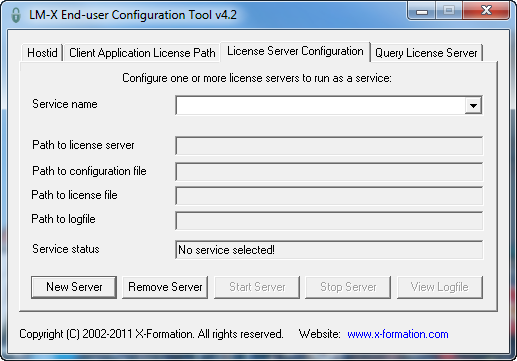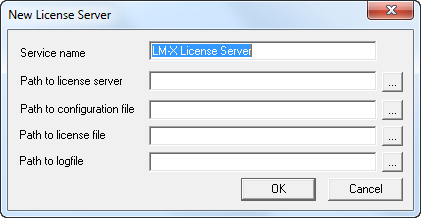| The information on this page refers to versions prior to 5.5, which extended the LICENSE_FILE setting to support specifying a license directory, and changed the LICENSE_FILE setting name to LICENSE_PATH.If you are using a previous version of LM-X, please see the documentation for the previous version. |
The following steps describe how to easily install a license server as a service on Windows using the LM-X End-user Configuration Tool (Windows only). If you are using a HAL (High Availability License) server configuration, see High Availability Licensing for HAL-specific installation information.
- Copy lmx-serv.exe and, if your vendor included a configuration file, lmx-serv.cfg into the directory where your server will reside. For example, C:\Program Files\Application.
- Start the LM-X End-user Configuration Tool, lmxconfigtool.exe.
- Click the License Server Configuration tab. This tab lets you manage license servers, including adding a new server, starting, stopping, and removing the server, monitoring its status and viewing its logfile.
- In the License Server Configuration tab, click New Server.
- In the New License Server dialog, specify the path to the license server location. For example, C:\program files\application\lmx-serv-vendor.exe. (You may browse for the file using the ... button.)
- If your vendor included a configuration file, browse for and select the configuration file location. For example, C:\program files\application\lmx-serv.cfg. (You may browse for the file using the ... button.)
- Additionally, you may add an optional license file and logfile to be used. Note that the logfile will override any settings for logfiles in the configuration file.
- Click OK to install the license server as a service. (Note: The license server will not start until you reboot your computer or start it by clicking Start Server. You will do this later.)
- If your vendor supplied a configuration file (lmx-serv.cfg by default), open it in a text editor, such as Notepad, and edit the entries for LOG_FILE and LICENSE_PATH to reflect the correct paths for your log file and license file.
If you specified a license file in the dialog, it will be read in addition to any specified in the configuration file. If you specified a logfile in the dialog, it will override any settings in the configuration file. (You may also need to make additional settings in the configuration file depending on your specific needs. For example, if you are using HAL licensing, you must edit the HAL settings as specified in How to install HAL license servers.) - In the License Server Configuration tab, click Start Server.
- Click View Logfile to verify the license server is started and working normally, indicated by the line "Ready to serve..." as shown in the following example.
[2009-01-25 20:43:07] LM-X License Server v2.1 on amilo (Win32 x86) [2009-01-25 20:43:07] Copyright (C) 2002-2009 X-Formation. All rights reserved. [2009-01-25 20:43:07] Website: http://www.lm-x.com http://www.x-formation.com [2009-01-25 20:43:07] License server has pid 17228. [2009-01-25 20:43:07] Serving licenses for XFORMATION. [2009-01-25 20:43:07] License server using TCP port 6200. [2009-01-25 20:43:07] License server using UDP port 6200. [2009-01-25 20:43:07] Logfile path: lmx-server.log [2009-01-25 20:43:07] License file(s): [2009-01-25 20:43:07] application.lic [2009-01-25 20:43:07] Serving following features: [2009-01-25 20:43:07] F3 (v1.5) (5 licenses) license type: exclusive [2009-01-25 20:43:07] F2 (v1.0) (5 licenses) license type: exclusive [2009-01-25 20:43:07] Ready to serve...
If there are any problems running the license server, the log file will indicate the cause of the problem. If you cannot find a log file, check to make sure that the correct configuration file was specified in step 6, and the configuration file contains the correct information. (Also see Limitations for installing LM-X License Server as a service, below.)
Limitations for installing LM-X License Server as a service
When installing LM-X License Server as a service, you should note the following limitations:
- The display name of installed LM-X license server service must be unique; if LM-X end-user tools have already been used with the LM-X License Server as a service, you must exercise care to use a different display name in subsequent installations.
- Two distinct LM-X license servers cannot be run as a service using liblmxvendor.dll files from the same vendor; for example, Server A can run with liblmxvendor.dll issued by vendor "XF", and Server B with "XFORMATION", but Server C can run with neither "XF" or "XFORMATION".
Uninstalling LM-X License Server
To uninstall LM-X License Server on Windows:
- Uninstall the license server using the command line or LM-X End-user Configuration Tool.
- Remove environment variables (you may use the Client Application License Path tab in the LM-X End-user Configuration Tool).
- Delete the remaining files such as License server configuration file, utilities, etc.

